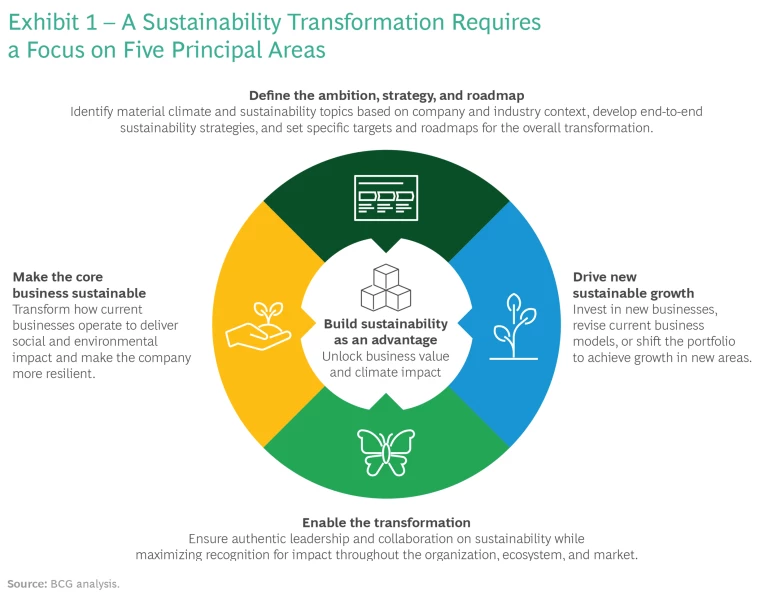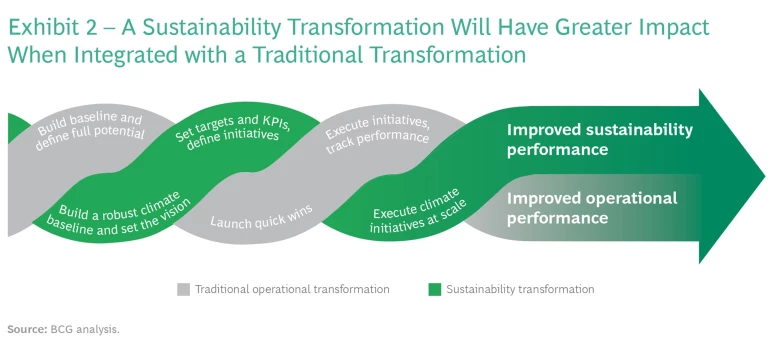When it comes to sustainability, senior leaders are shifting from ambition to execution—and that’s the hard part. Companies know they need to decarbonize and improve sustainability across their value chains, but often they struggle to translate that ambition into results.
Sustainability may be a relatively new objective, but the fundamental principles of transformation still apply. In the past decade, BCG has worked with hundreds of companies across a range of industries and with a variety of transformation objectives—from operational efficiency to boosting growth to implementing digital.
Based on that experience, we believe there are three main challenges that hold companies back in a sustainability transformation: determining where to focus for greatest impact, how to put the right transformation engine in place, and how to fund the journey. Understanding these challenges and applying time-tested principles to address them in a structured, systematic way can help senior leaders start achieving their goals instead of just setting them.
A Growing Imperative for Change
Sustainability performance is becoming a barometer of overall corporate performance. Awareness is growing among investors, customers, employees, suppliers, regulators, and other stakeholders, and it’s no longer sufficient to focus solely on financial returns. Failing to build climate and sustainability into a company’s strategy and day-to-day operations will result in the loss of capital, customers, and talent—and likely create regulatory issues as well.
In response, many businesses have committed to ambitious targets such as net zero. These are commendable, but companies often focus on the end goal and lack a clear plan for how to get there. In fact, failing to deliver on a sustainability pledge can be worse than not making the pledge in the first place, as it hurts a company’s credibility among stakeholders.
Large-scale transformations of any type are complex programs that require major investments and structured implementation efforts. Sustainability transformations are especially hard, for several reasons. Initiatives often span multiple business units and functions, making impact harder to quantify. And more often than not, the company doesn't control all the levers of change.
Success requires collaboration across the entire value chain, from raw-material suppliers to end customers, and often with industry coalitions and other stakeholders as well. Companies need to make their legacy business more sustainable, but they also need to identify and capture new opportunities emerging from issues of sustainability and climate change. Both challenges call for investments and new capabilities at the same time that new solutions and technologies are emerging faster than many companies can keep up with.
Awareness is growing among investors, customers, employees, suppliers, regulators, and other stakeholders, and it’s no longer sufficient to focus solely on financial returns.
On top of that, companies face increasing requirements to publicly report their sustainability performance, yet sustainability and climate data is noisy and inconsistent. Reporting standards continue to evolve, and some metrics developed by rating agencies can be arbitrary, pushing companies to focus more on their scores and less on the need for a comprehensive strategy that weaves sustainability into the company’s operations, products, and services.
Despite these challenges, companies must take action—today. There is clear value at stake in terms of meeting new customer demands, gaining access to capital, and mitigating risks. (See the sidebar, “The Value from a Sustainability Transformation.”) Companies can still differentiate themselves through superlative climate performance, but the window of opportunity is closing. In the very near future, sustainability will be table stakes.
Three Challenges
Climate and sustainability have become measures of corporate performance, and companies must take action to scope, plan, and integrate efforts to address these concerns into every aspect of the business. Implementing this kind of change is consistent with the basic principles of transformation. Leaders must be proactive, but they don’t need to start from scratch. Rather, they must understand the most common challenges and take systematic, structured action to address them. In our conversations with CEOs around the world, they cite three frequent challenges.

Where Should I Focus to Get the Biggest Impact?
Leadership teams often struggle to determine which aspects of the business should be prioritized in a sustainability transformation. To create competitive advantage from environmental, social, and governance initiatives, everything must be in-scope. Companies need to execute an in-depth, comprehensive transformation, not just a small number of isolated initiatives, embedding ESG across the organization to deliver real change. (See Exhibit 1.)

In a typical climate and sustainability transformation, some initiatives and activities focus on making the core business sustainable, while others focus on driving new growth through changes to the portfolio or business model. When all of these are addressed holistically, the company is more likely to successfully build competitive advantage. At the same time, the transformation must be integrated with the traditional transformations that most organizations already have underway, such as implementing digital, leveraging AI to enhance decision making, improving operational performance, or restructuring the organization. (See Exhibit 2.)
How Do I Put the Right Transformation Engine in Place?
Because climate and sustainability transformations are so complex, companies need a transformation engine to achieve the desired impact and sustain results. The transformation engine requires leader enablement, people engagement, and executional certainty (including strong governance and oversight backed by rigorous processes and tracking).
Leader Enablement. Leaders must be aligned, committed, and supported if they are to demonstrate new behaviors. Leadership coaching at the outset is critical, along with incentive structures that reinforce the transformation's objectives. At many companies, climate and sustainability are key topics for top leaders and boards, but that urgency and awareness needs to cascade down to the organization's managers. This means exploring ways to integrate ESG KPIs into performance targets and link them to pay and incentives. Leadership tools and playbooks can equip senior leaders to help manage the change, align the culture, and foster the right behaviors across the organization.
People Engagement. People are at the center of any change effort. Leaders need to make sure the entire workforce is engaged, committed, and has a clear sense of the overarching transformation. It is also important to communicate how work will need to change on a day-to-day basis and provide tools and upskilling opportunities to enable this shift. Before the transformation launches, an assessment can determine how ready the organization is to change. Transparent, consistent communications are critical to generate excitement about the transformation early on and keep the momentum going, with frequent updates about progress. And data collection can track the impact of changes in how employees work during the implementation phase.
Executional Certainty. Given the cross-functional nature of many initiatives and the inherent complexity of measuring impact, a sustainability transformation requires even more rigor during the execution stage than a traditional transformation to improve business performance. Companies therefore need to create governance processes, structured routines, mechanisms to track results, and interventions when necessary. All of these should be organized through a transformation management office that deploys governance and tracking infrastructure for both sustainability and financial goals. At the end of the day, only the mix of targets will differ from those of a traditional transformation—reducing CO2 emissions, for instance, in addition to improving EBITDA.
Failing to deliver on a sustainability pledge can be worse than not making the pledge in the first place, as it hurts a company’s credibility among stakeholders.
How Do I Fund the Journey?
Typically, large transformations require reallocation of resources across the organization—including capital expenses, operating expenses, and talent—along with additional funding. But the full amount does not necessarily need to be secured up front. Instead, smaller amounts can be unlocked rapidly in the early stages and used to fund subsequent parts of the program. Quick wins, sequenced in the right order, can make the effort self-funding.
Stay ahead with BCG insights on climate change and sustainability
That same principle applies to a sustainability transformation: companies should seek to generate rapid progress early on, which can build momentum for more ambitious measures that take longer to generate results. We also advocate integrating climate and sustainability initiatives into ongoing transformation efforts—one comprehensive program that spans the company’s operating model and value chain, aimed at the dual objective of improving both business and sustainability performance.
In some cases, initiatives will improve short-term financial performance as well as achieve longer-term climate and sustainability goals. Consider the example of a company that wants to transform its manufacturing operations. Rather than trying to upgrade the entire organization all at once, it makes a smaller investment to upgrade equipment at just one of its factories, which generates a clear ROI through gains in efficiency and throughput. Meanwhile, procurement considers the equipment’s fuel efficiency and water usage—making sure that operational improvement is coupled with improved sustainability. In addition, the company uses the factory upgrade as an opportunity to change the power source to renewables (which are often cheaper than fossil-fuel-based power and can generate carbon credits). It trains factory workers to reduce waste and rethink processes for further gains in efficiency. And it uses the savings and improvements generated by the changes at that factory to fund similar improvements at other production sites in other markets.
Companies have set ambitious climate and sustainability targets, but they won’t hit those goals without a formal, structured transformation process. There are several common challenges, but each has a clear solution. The same principles that underlie successful transformations to improve business performance apply to sustainability transformations as well. Armed with this insight, companies can start turning their sustainability ambition into action—and create a greener future for the world.
The authors thank their BCG colleagues Dave Young and Christoph Lay for contributions to this article.









